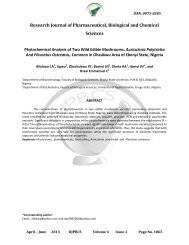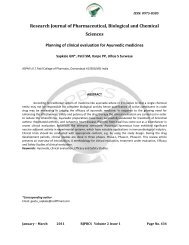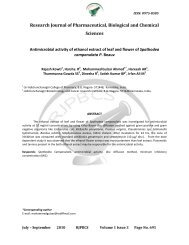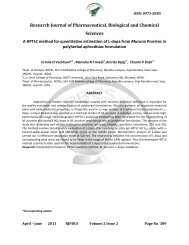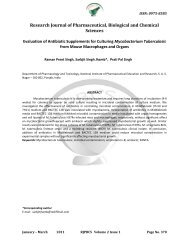A Pharmacognostic and Pharmacological Overview on Caesalpinia
A Pharmacognostic and Pharmacological Overview on Caesalpinia
A Pharmacognostic and Pharmacological Overview on Caesalpinia
Create successful ePaper yourself
Turn your PDF publications into a flip-book with our unique Google optimized e-Paper software.
Toxicity Studies<br />
ISSN: 0975-8585<br />
Preeja G. Pillaia <str<strong>on</strong>g>and</str<strong>on</strong>g> P. Suresh reported evaluati<strong>on</strong> of acute <str<strong>on</strong>g>and</str<strong>on</strong>g> sub-acute toxicity of<br />
methanolic extract of <strong>Caesalpinia</strong> b<strong>on</strong>ducella (L) Fleming was evaluated in Albino mice. The<br />
acute toxicity studies were c<strong>on</strong>ducted as per the OECD guidelines420 where the limit test dose<br />
of 2000mg/kg used. Observati<strong>on</strong>s were made <str<strong>on</strong>g>and</str<strong>on</strong>g> recorded after treatment at 2 hrs, 4 hrs, 8 hrs<br />
<str<strong>on</strong>g>and</str<strong>on</strong>g> then for seven days regularly for respirati<strong>on</strong> rate, heart rate, <str<strong>on</strong>g>and</str<strong>on</strong>g> behavioural signs like<br />
apathy, reduced locomotor activity as well as licking. For the sub-acute toxicity, three groups of<br />
6 mice were received distilled water (c<strong>on</strong>trol), 200 <str<strong>on</strong>g>and</str<strong>on</strong>g> 400 mg/kg of extracts every 24 hr orally<br />
for 28 days. No significant variati<strong>on</strong> in the body <str<strong>on</strong>g>and</str<strong>on</strong>g> organ weights between the c<strong>on</strong>trol <str<strong>on</strong>g>and</str<strong>on</strong>g> the<br />
treated group was observed after 28 days of treatment. Hematological analysis <str<strong>on</strong>g>and</str<strong>on</strong>g> clinical<br />
blood chemistry revealed no toxic effects of the extract. Pathologically, neither gross<br />
abnormalities nor histo pathological changes were observed. No mortality was recorded in 28<br />
days [75].<br />
Kumar RS, et al., reported investigati<strong>on</strong> deals with the hematology <str<strong>on</strong>g>and</str<strong>on</strong>g> hepatorenal<br />
functi<strong>on</strong> of <strong>Caesalpinia</strong> b<strong>on</strong>ducella Flem. <str<strong>on</strong>g>and</str<strong>on</strong>g> Bauhinia racemosa Lam. The tribal people of Kolli<br />
Hills, Tamil Nadu, India, use the leaves of <strong>Caesalpinia</strong> b<strong>on</strong>ducella <str<strong>on</strong>g>and</str<strong>on</strong>g> the stem bark of Bauhinia<br />
racemosa in combinati<strong>on</strong> with some other herbs for the treatment of various tumors, liver<br />
disorders, inflammati<strong>on</strong> <str<strong>on</strong>g>and</str<strong>on</strong>g> some other diseases. In ancient Ayurveda medicine these plants<br />
were menti<strong>on</strong>ed to possess antitumor agents. Since there are no scientific reports regarding<br />
the toxicological aspects of these plants, the present investigati<strong>on</strong> deals with the sub-chr<strong>on</strong>ic<br />
toxicity studies of a methanol extract of <strong>Caesalpinia</strong> b<strong>on</strong>ducella (MECB) leaves <str<strong>on</strong>g>and</str<strong>on</strong>g> Bauhinia<br />
racemosa (MEBR) stem bark in Swiss albino mice. The MECB <str<strong>on</strong>g>and</str<strong>on</strong>g> MEBR were administered<br />
intraperit<strong>on</strong>eally to Swiss albino mice twice a week for thirteen weeks. No significant<br />
alterati<strong>on</strong>s in hematological, biochemical <str<strong>on</strong>g>and</str<strong>on</strong>g> histopathological parameters were observed in<br />
the MECB- <str<strong>on</strong>g>and</str<strong>on</strong>g> MEBR-treated groups at the doses of 100 <str<strong>on</strong>g>and</str<strong>on</strong>g> 200 mg/kg body weight.<br />
Administrati<strong>on</strong> of MECB <str<strong>on</strong>g>and</str<strong>on</strong>g> MEBR at the dose of 400 mg/kg body weight elevated the levels of<br />
serum enzymes <str<strong>on</strong>g>and</str<strong>on</strong>g> altered the hematological parameters. Our results suggested that MECB<br />
<str<strong>on</strong>g>and</str<strong>on</strong>g> MEBR at doses 100 <str<strong>on</strong>g>and</str<strong>on</strong>g> 200 mg/kg body weight did not induce any toxic effects in the mice.<br />
Adverse effect was noted at the dose of 400 mg/kg body weight [76].<br />
REFERENCES<br />
[1] Asolkar LV, Kakkar KK, <str<strong>on</strong>g>and</str<strong>on</strong>g> Chakre OJ. Sec<strong>on</strong>d Suppl. To Glossary of Indian Medicinal<br />
Plants with Active Principles, PID-CSIR, New Delhi, 1992: Part 1,150.<br />
[2] White R. Legume web [Internet]. versi<strong>on</strong> 10.01. Cardiff (UK): Cardiff University, School of<br />
Computer Sciences. c 2005– [Revised 2005 Nov 1; cited 2008 Sep 23]. Available from:<br />
http://www.ildis.org/Legumeweb<br />
[3] Kirtikar KR, Basu BD. Indian medicinal plants. 2nd ed. Dehradun: Internati<strong>on</strong>al Book<br />
Distributors; 1988: 839-902.<br />
[4] Gaur RL, Sahoo MK, Dixit S, Fatma N, Rastogi S, Kulshreshtha DK, Chatterjee RK, Murthy<br />
PK. Indian J Med Res 2008; 128: 65–70.<br />
January – March 2012 RJPBCS Volume 3 Issue 1 Page No. 493



